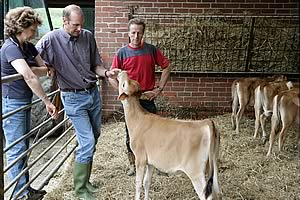 |
|||||||||
|
|||||||||||||||||||
Gold Cup finalist 2005, Ian and Sally Macalpine
Just three years after restocking their unit, Ian and Sally Macalpine, from Waddington, near Clitheroe, in Lancashire, have made it to the final of the dairy industry's most prestigious award - the NMR/RABDF Gold Cup. Their dairy farm is one of six finalists from across Britain and will be judged on factors such as physical and management performance, environmental schemes and their future plans for the dairy business. Ian runs his 195-cow pedigree Ribblesdale Jersey herd, and 110 young stock, on 85 hectares at Laneside Farm, with a lot of help from herdsman Les Helliwell. This is the second time Ian has entered the competition. "We entered out of interest last year. Our herd qualified to enter, with its low somatic cell count (SCC) and high PIN, so I thought I'd have a go and do something to promote the herd," he says, adding that the herd is only three years old, but already he has ambitions for it to become one of the top performing Jersey herds in Britain. "We re-stocked with Jerseys in 2002 after our previous Holstein herd was culled due to foot-and-mouth disease in 2001, so we were very pleased to make the semi-final last year. Making the final this year was a great surprise." Ian bought Jerseys when he restocked as he felt that the breed offered more options should he decide to move into marketing his own milk. At the moment milk is sold to Longley Farms for yoghurt and cream and Ian is easily able to meet the buyer's quality and hygiene requirements. The herd averaged 5,714kg of milk at 6.29% butterfat and 3.96% protein in 2004, with a SCC of 145,000cells/ml and a Bactoscan of 18. Ian manages the cows on a TMR-based system. The farm is in what Ian describes as a good grass growing area: "But the heavy clay soil and high rainfall mean that we have to take a flexible approach to grazing and it's not always easy to utilise the grass. "Grazing seasons can be short and it's not uncommon for the herd to go out towards the end of May and be back inside again by late August." Ian cares for his farm's environment, as well as the needs of his herd, and the unit has entered the Entry Level Scheme. He has regenerated hedges with laying and gap filling. Contractors are used to repair stone walls and there are some areas on the unit that have been earmarked for tree planting. Genetics are another of Ian's interests. "My aim is to breed economically sound cows that produce plenty of milk, with high constituent levels, and longevity." He says that the Jersey herd's vet bills are considerably lower than those of his previous black-and-white herd. "It's too soon to measure the longevity of my herd, but all the signs are that the cows should last. They are relatively trouble-free and I've one that's just calved for the tenth time. Many are in their sixth or seventh lactation." And, not content to simply restock, Ian has plans to expand herd numbers to 220 cows by Christmas. In a bid to free up space and labour for the extra cows, heifers are already being contract reared on another local farm. He also has other longer-term plans: "We enjoy setting achievable targets for our herd, meeting them and moving on to the next challenge. "We will continue to work towards developing the business and if it is possible, in these changing times, to make predictions about where we will be in 10 years time then we would hope to have another member of staff. "This would shorten our working day and free up a little more leisure time to spend away from the farm." |
|||||||||||||||||||

|
|
||||||||||||||||||
| home | agri-services | pedigree
pen | news | dairy | beef | machinery bps | property | organisations | site map |
|||||||||||||||||||

